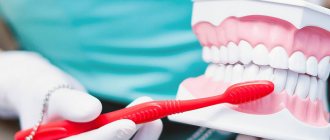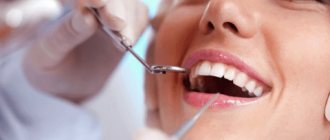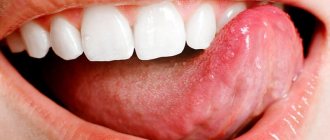Tongue brushing is an important part of oral hygiene and should be cleaned as often as your teeth. On the surface of the tongue there are numerous papillae, dimples and grooves in which microscopic food particles get stuck and bacteria accumulate, so the tongue is most susceptible to plaque. Regular tongue cleaning helps get rid of a huge number of pathogens that cause diseases of the oral cavity and teeth - glossitis, stomatitis, gingivitis, caries, periodontitis, etc.
Cleaning your tongue not only maintains hygiene, but also helps maintain a strong sense of taste. The tongue is responsible for the perception of taste. A pure language perceives it more clearly. You will discover new nuances of taste, and, oddly enough, you may start eating less.
In Ancient China, the nobility used a special tongue scraper before starting a feast. It was believed that cleansing the tongue helps to appreciate the true taste of food.
Did our ancestors clean their tongues?
People began using tongue cleaning devices at least five centuries ago. An example of this is the mention of the need to cleanse this organ of our body in the treatises of the 10th century AD. Uzbek doctor Avicenna. For the most effective procedure, he recommended using cypress cones and tree slivers, which are rich in essential oils. In ancient China, members of the nobility used a tongue scraper to clean their tongues before each meal, as it was believed that thanks to this procedure they could fully appreciate the taste of the dishes. Residents of our country made special scrapers from silver, which disinfected the oral cavity and prevented various inflammations such as mouth ulcers, candidal stomatitis, various types of glossitis, etc.
Is it necessary to clean your tongue of plaque and why do it?
The tongue should be cleaned of plaque every day during morning hygiene procedures.
Regular and high-quality cleaning of the taste organ:
- reduces the concentration of pathogenic bacteria in the oral cavity;
- is an excellent prevention of infectious diseases;
- prevents the development of digestive problems;
- helps protect tooth enamel and prevents caries;
- eliminates unpleasant odor from the mouth;
- improves taste perception.
According to traditional Chinese medicine, there are 40 acupuncture points on the tongue that affect the brain. Cleaning the tongue acts as a kind of massage that has a positive effect on the functioning of the brain, which improves attentiveness and concentration.
Tongue of a healthy person
The tongue of a healthy person is pink. It should be elastic, moist, without wounds, cracks and swelling. Even with ideal health, a thin layer of white or gray plaque periodically forms in the mouth, which can be easily removed by carrying out simple hygiene procedures.
But the plaque can be different: one can be removed on your own, while the other can only be removed after long-term treatment under medical supervision. Plaque on the tongue is a kind of indicator of a person’s health status, therefore, if there are any changes in its color or structure, you should consult a doctor to identify and treat the disease that triggered the development of such signs.
Cleaning your tongue with a tongue scraper
Nowadays, tongue scrapers take pride of place in the list of oral hygiene devices. Almost all of them are made of plastic and are a nozzle with a spoon-shaped tip. This excellent tongue and cheek remover needs to be replaced as often as toothbrushes. If you use it together with a rinse aid, the quality of the procedure will be one level higher. You can buy a tongue scraper at a pharmacy or order it from an online store.
Preventive measures
It is easier to prevent the formation of plaque on the tongue than to treat its pathological form. The following preventive measures will help with this:
- Perform comprehensive oral hygiene morning and evening.
- Monitor the condition of the gastrointestinal tract and treat diseases of the digestive system in a timely manner. They are most often the cause of pathological plaque.
- Stop smoking and drinking alcohol.
- Consume spices, smoked and spicy foods in moderation.
- Treat caries and other dental diseases in a timely manner. Get preventive examinations at the dentist.
- Drink more and eat vegetables and fruits with a high fluid content, because dehydration can be the cause of plaque on the tongue.
Thus, brushing the tongue is an important part of oral care. It helps to avoid the problem of bad breath, reduces the risk of developing inflammation in the mouth and serves as a prevention of dental diseases. Plaque can be removed in different ways, including with a regular toothbrush. In addition, it is necessary to follow preventive measures to avoid the appearance of pathological plaque.
Tongue cleaning spoon
A tongue cleaner is just as great for removing plaque and bad breath as other tongue cleaners. It is a nozzle with a spoon-shaped tip. Using this water-supplying nozzle, you can clean your tongue quite gently and effectively. It is known, for example, that yogis use a wooden spoon or clean their tongue with three fingers wrapped in a clean bandage. You can also use an ordinary teaspoon, but then only for cleaning and, of course, individually.
Clinic doctors
Cleaning your tongue is an important part of your daily oral hygiene. The surface of the tongue has a heterogeneous structure - it has many papillae, as well as tubercles and grooves where microscopic food particles accumulate, plaque collects and bacteria multiply. Therefore, the tongue should be given no less attention than the teeth.
Benefits of brushing your tongue
Regular tongue cleaning will help:
- prevent the development of caries - microbes in the oral cavity produce acids that corrode tooth enamel;
- free the tongue from a layer of plaque - it not only looks unsightly, but is also a breeding ground for bacteria;
- get rid of bad breath - it is caused by chemical compounds produced by microorganisms;
- improve the quality of perception of the taste of drinks and food - if you do not clean your tongue of plaque, the taste buds gradually become clogged with waste and toxins.
How to clean your tongue
There are different devices for cleaning the tongue:
- Scraper. There are several types of tools - in the form of a handle with a loop at the end, similar to a razor (but instead of blades it has a soft rubber coating) and a flexible curved metal strip. Plastic products are more gentle, but, like toothbrushes, they need to be changed regularly. It is enough to treat metal scrapers with a sterilizer from time to time or simply keep them in boiling water for a couple of minutes.
- Toothbrush with a ribbed surface. On the back of the working head there is a rubberized tab with which you can clean your tongue. But this device is not as effective as a scraper. Also, due to the large thickness of the head, the brush is not suitable for people with a strong gag reflex.
- Spoon. A tool in the form of a long handle with a spatula at the end copes with plaque as well as a scraper, but covers a smaller area.
- Silicone fingertip. Designed for kids. The fleecy or ribbed surface of such a brush cleans the tongue and mucous membranes of the oral cavity well. Recommended for use after the appearance of the first tooth and up to one and a half years.
How to properly clean your tongue
You can clean your tongue from plaque either with or without paste. If you use a paste, choose a product without a strong mint flavor: excess menthol irritates the papillae and can cause a burning sensation. Smokers are advised to use special pastes, since the residue from tobacco smoke is much more difficult to remove.
You need to clean your tongue from root to tip using “sweeping” movements. If a gag reflex occurs, it is better to use a scraper and not try to completely get rid of plaque immediately. In the first days, it is enough to treat the tip of the tongue; as you gradually get used to the procedure, you can move higher. The final stage after oral hygiene and tongue cleaning is rinsing with water, a special solution or infusion of medicinal herbs (chamomile, sage).
Prevention of plaque formation on the tongue
Modern methods of cleaning the tongue allow you to quickly get rid of plaque. To reduce its formation, we recommend following simple rules:
- do not abuse fried, fatty, spicy, smoked foods;
- eat fresh fruits and vegetables;
- introduce more fermented milk products into your diet.
- improve immunity;
- prevent any diseases from becoming chronic;
- maintain oral hygiene.
Tongue scraper brush
Many companies specializing in the manufacture of oral hygiene products offer so-called tongue scrapers. This device is a combination of a brush and a scraper; it has an elongated round shape with soft bristles. Thanks to its flat shape, cleaning the tongue is much easier (does not cause a gag reflex). You can also find brushes on sale that have bristles on one side and special rubber or plastic relief strips on the other.
Why does plaque appear on the tongue and its signs?
There is plaque even on the tongue of a completely healthy person. It appears because particles of consumed food are retained between the taste villi and lingual papillae, causing the active proliferation of bacteria. Over time, bacteria die due to the work of the immune system, but they do not disappear without a trace - food particles, saliva, keratinized epithelial cells, dead microorganisms and their metabolic products settle on the tongue and form plaque.
During eating and thanks to salivation, plaque almost completely disappears from the surface of the tongue. However, most often the basal region and the root of the tongue remain covered with a thin film, through which the lingual papillae can be easily seen. This residue is also littered with germs that can trigger the development of numerous dental diseases - which is why you need to regularly remove it when brushing your teeth.
Signs of plaque on the tongue are within normal limits
Even in the absence of supporting symptoms, coating on the tongue may indicate health problems. But you shouldn’t run to the doctor immediately after discovering this unaesthetic film. Sometimes it is normal, in this case you just need to regularly clean your tongue and remove the plaque that forms on it. But if there are pathological signs, it is necessary to visit a doctor as soon as possible and undergo a diagnosis.
Plaque occurred due to natural physiological reasons if it:
- whitish or yellowish;
- homogeneous;
- does not cause pain;
- covers the root and basal region of the tongue with a thin layer, and the lingual papillae are visible through it;
- easy to remove with regular hygiene;
- appears after eating food, in the morning, due to thirst;
- has no unpleasant odor;
- not accompanied by other symptoms.
Signs of pathological plaque on the tongue
A coating covering the tongue may indicate that the body is experiencing certain problems.
In such cases it becomes:
- thicker and denser;
- not amenable to removal;
- yellow, gray, brown, green, red or even black;
- covering the entire tongue or its lateral parts;
- smelling bad;
- accompanied by a bitter taste in the mouth.
You can find out whether the appearance of white or yellow plaque is normal or indicates health problems in the following way: brush your tongue and teeth with a toothbrush and toothpaste and see how long it takes for fresh plaque to appear. If it forms three hours after it was removed, then everything is fine. If earlier, it’s time to pay attention to the state of the gastrointestinal tract.
What diseases may a coating on the tongue indicate?
It is impossible to determine the cause of plaque formation at home; for a reliable diagnosis and prescribing the correct course of treatment, you should consult a doctor. But you can guess what diseases could lead to the manifestation of such symptoms on your own.
Candidal glossitis (thrush)
Yellow, yellowish-gray and white plaque may indicate the following pathologies:
- disruptions in the digestive system, inflammatory processes, dysbacteriosis;
- gastritis, stomach ulcer;
- impaired intestinal motility, flatulence, problems with bowel movements;
- liver damage;
- inflammation of the oral mucosa (glossitis);
- diseases of the gums, teeth, palate;
- disturbances in the functioning of the endocrine or hormonal system;
- poisoning, malnutrition, mild dehydration;
- the presence of worms;
- malignant and benign formations.
A greenish coating may indicate fungal diseases and long-term drug therapy.
Brown is a constant companion of people who abuse smoking, drinking alcohol and eating heavy food. In addition, it may indicate diseases of the upper and lower respiratory tract.
Villous glossitis
Black plaque is rare and usually accompanies serious diseases such as:
- Crohn's disease;
- severe dehydration of the body;
- increase in blood acidity;
- villous glossitis;
- pancreatitis or cholecystitis.
It should be taken into account that consuming products containing strong dyes also affects the color change of plaque in the mouth. If it turns yellow or blue-green immediately after eating a candy of a similar color, then there is no need to look for another reason for this phenomenon.
It is almost impossible to get rid of pathological plaque in the mouth on your own, even by regularly removing it. Eliminating the symptom once and for all is possible only with proper treatment of the causative disease.
Is it possible to clean your tongue with a toothbrush?
Yes, an ordinary toothbrush with a small amount of toothpaste is often used to clean the tongue. In this case, a soft or medium-hard brush will be more suitable for you. To clean your tongue, you can also use a toothbrush with a special surface on the opposite side of the bristles. After you have brushed your teeth and rinsed your mouth, you just need to turn the brush over and start the procedure. Movements should be carried out in the direction from the back of the tongue to its tip. For the procedure, you can use not only a regular toothbrush, but also an electric or ultrasonic one, as well as an irrigator. If you are the owner of one or the other, then you just need to purchase an additional attachment for cleaning your tongue.
Insufficient cleansing of the tongue leads to the development of bacteria, which, in turn, can affect the occurrence of bad breath, diseases such as glossitis, stomatitis, caries, etc. Therefore, it is necessary to remember the hygiene of the entire oral cavity - teeth, gums and tongue.
Technique of the procedure
We have figured out that cleaning the tongue is a prerequisite for maintaining oral hygiene. But how to properly clean the surface of the organ from white plaque, which naturally accumulates during the day and during sleep. For these purposes, you can get a special scraper, but a standard brush can cope with this task no less effectively. Moreover, today they produce modern models with a ribbed surface on the back of the head - it is created specifically for cleaning the tongue. The procedure is recommended to be carried out as follows:
- After brushing your teeth, move on to your tongue. We start from the root, gradually moving to the tip, using “sweeping” movements to remove accumulated plaque and food debris, without excessive pressure,
- first we go through one half of the organ, then we clean the second,
- then we brush across it several times. If desired, add toothpaste and go over the entire surface again, but this time from tip to base,
- At the end of the procedure, you need to rinse your mouth thoroughly.
Cleaning should start from the root and move to the tip.
For these purposes, baking soda or propolis are often used, but before turning to traditional medicine for help, it is better to consult a dentist.
Why is this necessary?
The need to clean the tongue daily has been proven by numerous studies confirming that this is the prevention of dental diseases such as caries and its complications, soft tissue diseases - gingivitis, glossitis, stomatitis, etc.
Let's understand the physiology of the oral cavity and the anatomy of the tongue as an organ. The tongue is a muscular organ of the oral cavity that performs many functions:
- speech education
- formation of a bolus of food and pushing it along the digestive tract
- taste perception, which is controlled by the taste buds
Its surface is extremely heterogeneous and has microspaces, grooves that accommodate various bacteria, since they create the most favorable conditions for their reproduction - humidity, the presence of nutrients, the absence of light and oxygen. The proliferation of microbes leads to inflammatory diseases and an unpleasant odor.
The microflora of the oral mucosa contains normal flora and opportunistic flora, the latter, when immunity, both general and local, is weakened, can become pathogenic (streptococci, staphylococci, etc.). For example, Str. Mutans causes the development of dental caries.
People who regularly brush their tongue are 10 times less likely to suffer from various oral diseases. If this is not done, then other provoking factors increase the risk:
- The proliferation of bacteria leads to the development of glossitis, stomatitis, gingivitis, caries
- Plaque and tartar deposits form, which leads to bad breath - halitosis.
- A coated tongue and bad breath in active people can lead to complexes and problems in communicating with others
So why do we clean our tongue?
- Removing pathogenic bacteria and plaque
- Daily massage of the tongue receptors during cleaning stimulates and activates the work of internal organs
- Prevention of caries, stomatitis, gingivitis, tartar deposits, etc.
It should be noted that the appearance of plaque on the tongue most often indicates dysfunction of the digestive system, liver, and gall bladder (see why white plaque forms on the tongue, causes of yellow plaque), therefore the fight against plaque should include treatment of the disease leading to it.











